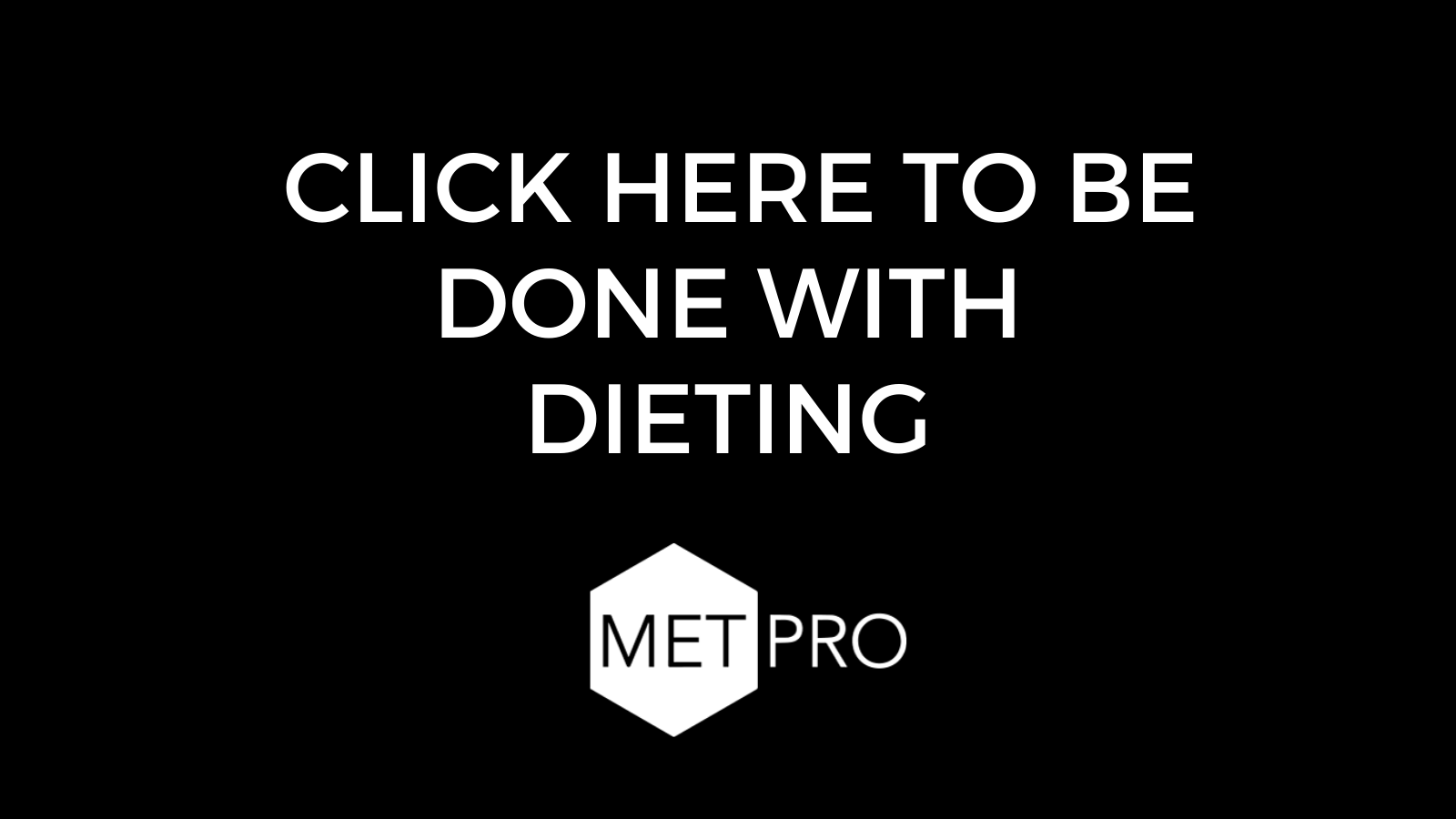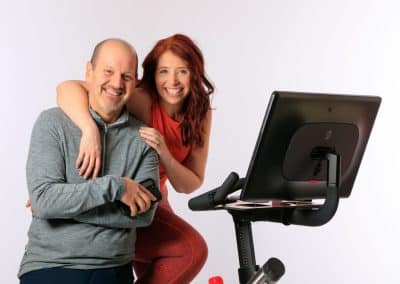I'm joined by MetPro Coach, Ryan McMullen, and MetPro Creator, Angelo Poli. We will be discussing fuel for endurance athletes. Ryan and Angelo, thank you both so much for joining me.
Thanks for having us.
It’s fun to be here, Crystal.
I am excited to talk about this subject. Let's start with why we are discussing it. Why is it important to discuss fuel for endurance athletes specifically?
I’m glad we are bringing this to light because it’s a common question. A lot of our clients are endurance athletes. They are cyclists, runners, swimmers, triathletes, or Ironman athletes. You name it. They carry a specific set of what they need to get through this endurance. It's not just the food that they are eating throughout the day. Particularly, for the endurance athletes, that's why we are discussing it and why we are bringing to light what people need to know in regards to fuel.
I like this topic because I like to win. My athletes know that about me. I am a big fan of winning. If we are going to compete, let's do well. Let's give it our all. It's probably the single, easiest, lowest-hanging fruit. I'm talking about high-level athletes who are more competitive. When I start with a new athlete, if they do not yet have structure to their nutrition like they eat well and know a lot of the right strategies but don't have a calculated structure, with about 90% confidence, I can say that ay within two weeks, we will be able to hit some PRs. It's that impactful. Having structure in your nutrition is hard but if you want to take your performance as an endurance athlete to the next level, it makes all the difference in the world.
If we are saying fuel, in general which is food, are we simply saying it's important to work out or to eat before you work out? Is it more nuanced than that?
The famous answer is it depends. It’s so interesting because I talked to my clients all day about this. Some need something substantial in their stomach before they go work out. If you are like me, I don't like something in my stomach, at least substantial where there are some proteins, fats and carbs. I feel full and not great. That's pretty typical across the board. You are going to find some people do better with something in their stomach and some with nothing. Nothing is the scary part because then we need to talk about pre-fueling and what you need particularly for that endurance-type activity.
Someone is comfortable getting in their breakfast before they go workout or maybe it's later in the day. It’s a little bit easier because they have something in there but for those that don't work out, some pre-fuel might be necessary and then segue that into fueling during their exercise depending on how long it is.
Everyone's digestive system is similar. Typically, what most people are thinking of here is if you train in the morning. If you train later in the day, you will have to eat first. The question is, “How first?” Is it 30 minutes before or 2 hours before? We are specifically talking about AM fueling, “Should I have breakfast before I work out?” Here's the truth. If you are a beginner, that's up to you and your digestive system. If you are getting up and planning on running 18 to 24 miles, you will need fuel if you want to perform your best.
Who is doing that on a given day unless there's a marathon?
I can give you a few names. I’ve got a guy who’s getting ready for the Ironman at Kona. He's in the top 1%. You would be amazed at the fuel that we are packing down him first thing in the morning. To Ryan's point, we have to get creative at that level. I need to get him a lot of grams of carbs but he can't feel like he has a heavy stomach sloshing around. That's where a little bit of strategy comes in. Ryan gave the correct answer. It depends on what you are trying to achieve. Generally speaking, if PRs are your primary consideration, more fuel is better than less fuel as a general rule.
What types of activities need fueling? Are we saying every workout? Are we saying certain types of endurance workouts? Narrow it down for me a bit.
All workout needs fuel. If you are strength training, in the pool or doing endurance work, it does not matter. All training needs fuel. It depends on the length of time that you are going to be out there. If you are in the gym doing strength training and you have breakfast beforehand and then go to the gym and do an hour of a strength training workout, there's fuel in your nutrition. There's fuel on a day-to-day basis.
If we are talking about endurance work that lasts beyond an hour, for example, 90 minutes or 2 hours long in these big runs, we are discussing fueling for that length of time. All working out needs fuel. It's just what do we need to fuel for that specific type of exercise? Angelo and I are talking about endurance. That is the area that we are talking about that needs proper fuel.
It’s true. There are additional table stakes. When you are talking about higher-end endurance athletics, there's a little bit more wiggle room. I've even competed with but mostly trained with some very high-level strength athletes, and powerlifters. There's a little bit more forgiveness as to how they choose to fuel right before they go in and try and hit a PR.
If somebody plays around with their nutrition and doesn't have a good structure, a good game plan, and a routine in place for their pre-run fuel and they are about to go and try and hit a PR doing a marathon, that is not the time to experiment. Things can go sideways fast. Part of that is the central nervous system drain and the taxation level on your entire musculoskeletal system, digestive system, and energetic system when you are pushing your body to that level of endurance.
Part of it is the mechanics of how your body utilizes fuel. With endurance athletes, there are extra table stakes where you could be conditioned properly for the activity and the demands. If you run out of fuel because you are at it for too long and you haven't optimally replenished your glycogen stores, you end up having to tap your reserves and simply reach a point where your body can run out of fuel prior to reaching your absolute potential and performance had it not run out of fuel. That's why this is most common among endurance athletes.
Having said all of that, how do you know how much fuel you should be using for the different types of workouts?
This is probably the most important thing. With my clients, I like to work backward. I start with goals and how long it's going to be lasting for. I make my clients pick, “Is your goal fat loss? Is it still weight loss? Are we still trying to get the body composition to a point where you are happy with your fighting weight? How long is the activity going to last?”
I will start with the person that's still wanting to lose weight. If that person is doing anything that lasts longer than an hour of exercise, they are going to need something but the amount of fuel that they are going to intake is less because we are not shooting for these massive PRs or performance-oriented goals setting. For that person, my recommendation is 20 to 30 grams of carbs per hour beyond 1 hour to 1 hour and 15 minutes of exercise. If it's going to be an hour-long or less, 40 minutes of activity, they don't need anything because their goal is still a fat loss. We can control that through nutrition. Anything beyond that, I'm going to want them still fueling.
I joke with my clients that this is a get-through to their workout, not performance-based. If you cycle into performance-based athletes, they are happy with their weight and body composition, that's an entirely different set. The grams increase to 40 to 60 grams per hour of exercise beyond an hour of exercise. That’s performance-based so there's no fat loss goal going on there. There's no weight loss goal happening. That is purely to get them the best times, structure, and the best that they can feel throughout their run.
Ryan is correct. That is the most technical question that we will probably cover, “Do you know how much to fuel?” That is specifically what we do at MetPro. We run all of our analytics and watch how your body responds to get to that answer because the truth is that answer is going to be very different for each person. Ryan threw out some very good, simple starting point numbers that would be a great starting place if you are unsure where to begin. I also like how he said work backward. That's the key.
I always like to be able to give people a sense of practical action steps like, “How much should I fuel? What can I do tomorrow?” These are generalized but the first thing I would recommend is to start getting consistent meals throughout the day. If you are an endurance athlete looking to increase your performance, I would love to see you eating consistent meals roughly equivalent anywhere from 4 to 6 times a day. They don't have to be identical in macros but instead of having all of your calories in one meal at night and then hardly anything throughout the day, try and get them somewhat even throughout the day. That should be goal number one.
Goal number two is if you do that and you are not gaining weight, you likely have room on the table to increase. Any increase in your fuel, particularly in the form of carbohydrates, is going to enhance your performance as long as it doesn't lead to excessive body fat gain. Most people are surprised at how quickly their metabolism will acclimate to increased carbohydrates when they are doing regular endurance work. If you find that you are eating 4, 5 or 6 times a day, add up how many grams of carbs you are getting on average and see if you can increase that to 5% or 6%.
If a few days later you are not gaining weight, try again. Some people find they are able to increase 15% to 20% in a matter of a couple of weeks. That's all fueled to aid in your performance and recovery. I have had clients who have been able to triple their carbohydrate intake. I have one high-level athlete. He was eating 140 to 160 grams of carbs a day because that's what he thought his body could tolerate. By increasing gradually, he was able to get up to nearly 400 grams a day. He killed it in competition. He put on about a pound of muscle.
The reason we don't talk about that as much is that a lot of people are also running, cycling or participating in endurance sports at the same time with a goal of fat loss. The rules shift a little, and we will talk about that later but all things being equal, try and have more fuel. If more fuel is causing a negative side effect, which would be body fat accumulation, then stop.
Don't assume that more fuel, if added gradually, will cause that. Wait and see. Don't be scared. You are not going to wake up, look in the mirror and go, “What happened?” That doesn't happen overnight. You are going to have plenty of heads up if it's too much fuel for your body. Start gradually. You might be surprised how that can transform your running, cycling, or endurance times.
We've got some good guidelines for how much fuel to intake. When do you consume this fuel when you are going to be working out?
Pre and during is the simple answer. You need something going in. If you are going to embark on an hour-plus of endurance work, whether that's cycling, swimming or running, you need something beforehand. Normally, it’s a breakfast or some form of snack that's got a good balance of protein and carbs. That's going to set you off on the right track, and then during the exercise is the key. Finding that person-to-person is going to be a little bit different but what I like to tell my clients is it's better to be ahead of it than to be behind it.
Once those glycogen stores are gone, it is hard to replenish them and get them back up. That 20 to 30 grams per hour if your goal is fat loss, it is 40 to 60 per hour I like my athletes taking it right around the 40 to the 45-minute mark. That's going to give the body time to digest, process, and replenish those glycogen stores so they don't have those dips and then those massive peaks in energy. The idea is to have a flat line and stabilization of that energy throughout whatever they are doing.
That's it. It’s pre and intra-training fuel. With my clients, we are always riding that line because a lot of people come to us with dual goals. There's nothing wrong with that. It's recognizing that the table stakes are different. They are like, “I want to get PRs. I want to improve my performance but I also want to see bodyweight reduction.” You have to know what your goal is.
Here's a small nuance that will maybe help our audience. When somebody is coming to me, and we are not talking about a performance athlete or an endurance athlete, to become more athletic and lose weight. When we go through metabolic revving cycles, which are periods where a goal is to acclimate their metabolism to more intake, why do we do that? It’s so we have leverage for a good cutting cycle. Lots of people say, “Cutting carbs works well for weight loss. Why aren't you doing it?” I’m like, “You've got your carbs. You don't have any more to cut. That’s why.”
In those cases, the typical strategy is going to be the more meals you can spread the carbs out across the day, generally, the easier it is to get your body to acclimate without that side effect that we talked about, which is fat accumulation. We are spreading them out evenly across the day. I get asked all the time, “Where do I begin? Do I start by adding to dinner, lunch, breakfast, or snack?” The answer is to start early in your day. All things are equal. If someone was getting a small number of carbs across the day in all of their meals and I want to increase them further, I would generally start with breakfast and then work towards lunch, and then lastly, work up through afternoon and snack towards dinner.
Here's a nuance difference. If I have an athlete who's participating in endurance sports, sometimes I will bend that rule and I will add the first increase to whatever meal is prior to their training. If they train in the afternoon, I might first add the increased carbs to lunch. What I would never do, however, is add the 2nd, 3rd, and 4th increase also to lunch.
Once you increase that meal a little, spread the rest throughout the day and you can circle back. You want a roughly even distribution where it is possible with a slight nudge and increase leaning towards pre-training fuel. Carbohydrates are going to be the dominant fuel source or macronutrient that's going to facilitate that performance and energy.
When you are specifically doing an endurance workout, when do you fuel during that? I know earlier, Ryan, you said there are some guidelines that you have and should be thinking about pre and during but what specifically should we be looking for in your endurance workouts?
I will handle that one. That's along the lines of what Ryan said. About 45 minutes is the sweet spot. You have some wiggle room. I tell people on average to start adding intra-training fuel. You are supplementing with high-glycemic, essentially sugar, during your runs, rides or endurance activities if you are going to be doing an activity that lasts over about an hour and if there's wiggle room.
With some of my athletes, I know they are well-tolerant to it, I let it go to 1 hour and 15 minutes because their primary goal is fat loss. My high-level athletes who are in the training trenches get ahead of it. We have them start doing it around 45 minutes. In general, if you are going to participate in an endurance activity that lasts between 1 to about 2 and a half hours, supplement with 25 to 30 grams per hour. If you are going to be participating in an activity that lasts over two and a half hours, that's where you can bump that up to 30 to 60 grams. Some people don't need as much.
If you have some dual goals, you have a little bit of wiggle room. 60 grams an hour is pushing the threshold of what humans can absorb. Some of my high-level athletes were okay with a little bit above and beyond what they can absorb. This is an area that's highly individualized. Each person will have to experiment a little bit to find what that sweet spot is.
Tier one is if you think you need endurance supplements and to take sugar supplements during your run because you are going to run for about 35 minutes, you probably don't need it. Let's start with getting you solid nutrition. If you are going to last over an hour, start thinking about adding that 25 to 30 grams an hour range. If you are at that athletic level where you are over two and a half hours, it's that 30 to 60 ballpark that you want to start experimenting with well in advance of your competition to know what works.
To piggyback off of that a little bit too I'm doing this with a few of my clients as well. Sometimes figuring out what fuel the race is going to provide is essential and critical. I have some athletes say, “This race, in particular, is providing powdered Gatorade.” Is it my favorite? No, but do I want their stomach and their digestion to be acclimated to it? Absolutely.
I have a client in Australia. He is coming up on a marathon. They have a very specific supplement that they are going to offer and provide during the race and I have him on that. We are fifteen weeks out from his race and I want him to get used to that supplement to make sure that it's not going to cause any sloshing around or digestive upset. If you are signing up for a race, finding out what fuel they are going to offer and then bringing that into your diet early on as your source of fuel can be incredibly beneficial.
That is an excellent tip right there because my stomach cannot tolerate Gatorade at all, even a sip of it. It’s not good. I always take mine with me because races always have Gatorade here. I stay away from it. Ryan used the marathon as an example, so we will go with that. There are days that you are not necessarily working out at all. What if it's just a normal workout and it's not a training day? Do you need to change fuel? Do you need to do anything extra other than good nutrition?
I'm sure Angelo is going to expand on this way more than me but I like using nutrition as our variable. Piggybacking off of what he said, it’s creating that slow increase in carbs and what your body can tolerate. That's our variable. What we want to focus on is day-to-day nutrition. Fueling is static. Fueling can be that static point where we are not shifting around much like, “What is your goal? Is it fat loss or performance? That’s great. Here are the carbs that you are going to intake during exercise that lasts longer than 1 hour or 1 hour and 15 minutes.”
For a person that's training on a day-to-day basis, maybe their runs are a little bit longer, we are going to have them fueling for that, but that's not my focus. My focus is on taking their breakfast, lunch, dinner, and snacks in between and shifting those as they move through their training process. Variable is the day-to-day stuff and the static is that fuel for exercise depending on how long it lasts and your goals.
Ryan has done this a couple of thousand times. Here's the deal. I meet people where they are at. If where you are at is the drive-thru well, then let's work on quality foods. You are going to see benefits from that. Once you are to the point where you already understand and appreciate the value of healthy, clean eating, for the most part, then the next level is consistency. That's going to open up this whole additional gear you never knew you had available to you.
Whether your goal is weight loss, muscle development or PRs in your endurance sport, having a consistent routine is my absolute number one goal with any client out the gate. The reason why is because no matter what, you are going to hit plateaus in your progress, which are plateaus towards new PRS, body composition or weight goals. When you hit those plateaus, you are going to say, “Angelo, what do I do?” If you say to me, “I eat something different every day,” I am then going to say to you, “I don't know,” and I hate having to say that to my clients.
That’s a very different answer from, “It depends.”
I don’t know and you don’t know. We don't know what you are eating, so we don't know what is or isn't working, which is why exactly what Ryan said. I would rather have you almost over fuel during your intra-training routine. In other words, you take whatever fuel you need, so in that way, you never have to worry about coming up short during those endurance sessions. On every other day of the week, I want to have a routine. You read lots of articles where fitness gurus will say, “You have days where you eat more carbs and days where you eat fewer carbs.” They are not wrong. What they are is frankly impractical.
What I find is if someone is changing what they are eating day in and day out, over time, it always segues into nutritional chaos. It's simply too many hours a day to switch your meal plan and to prepare for different macros or different routines. Every day of the week, you are doing something different. I have a hard enough time getting my clients to stay consistent when I tell them, “For the next two weeks, here's what we are doing for breakfast, lunch, dinner and snacks. You can shop for it, plan for it, and have it all ready to go in advance.” Even with that, it's a challenge.
Let alone say, “On Tuesday, we are going to change everything, and then you are going to be back to this routine on Wednesday. On Thursday, we are going to change everything again.” It doesn't work. Scientifically relevant or not, from a practical standpoint, you won't do it. Therefore, I would much rather have a consistent lever where I can say, “I like where we are going. I like your performance but how about we cut 3 to 4 pounds off of you? I know exactly what recommendations to make.”
“You are doing well. You are at good body weight. Let's push for that PR end of this month. Here's what we are going to do. We are going to start increasing giving your body a little more leverage. Here's a little more fuel but we are going to add slowly, so by the end of this week, we are going to make the first adjustments, and the next week, we will try making the second adjustment. We are going to watch and see what happens.”
We do this at nauseam. With our clients at MetPro, that's what our whole platform is designed to do. It’s leveraging technology to help us get all of these analytics. We have these bars and these metrics that tell us whether you are likely to increase, decrease or stay the same way based on what you are eating over the next 6 to 9 days. We have all those metrics. However, anyone can apply the principles. It's very simple. If you want to recover faster or want more endurance, take in more fuel. If you are not sure if you can handle more fuel, try, and if you start gaining weight, stop.
That’s the basics. That sums it up.
You have to have a platform to spread it out throughout. It can't be like, “I ate a little more yesterday.” When we were on site before we switched to working remotely across the world, people would come to my office. I had this custom sign made that would be right behind where they would sit. This sign said, “I know this isn't how you usually eat.” On every consult I had, they would share with me what they ate yesterday or the day before. Every single person would say, “It's not how I usually eat.” I would say, “I know. There's a sign. Turn around.”
Humans are inherently bad at recalling what we take in as fuel. Our dietary habits are very poor. This has been studied to a great degree. Humans are inherently bad at recognizing and recalling on average what we have eaten. That's why if you have a routine, you have something you can anchor to. You have a dial and a lever to adjust and you are going to get a predictable outcome. That's what it's all about being strategic.
Is there anything else that we need to let people know about fuel for endurance athletes that we haven't already covered?
The last thing I would say is everyone's body is different. There's always going to be a trial and error. Even working with a professional, there's going to be some level of trial and error. Our team is pretty good at figuring those things out really fast but each person is individual. Your digestive and recovery systems are going to be unique. The meal plan that one person may think is a starvation diet may feel like too much food for the next person. The key is finding out where you are at, and then based on that having your levers and dials to adjust.
Thank you both so much for your time. I appreciate your time, Ryan and Angelo. Readers, that’s all. You can find The MetPro Method episodes anywhere you get to tune in or MetPro.co/podcast. Please be sure to follow the show and rate and review. That lets other people know what they can expect from the show. You can also learn more about MetPro at MetPro.co. I will be back with another episode. Until then, remember, consistency is key.






